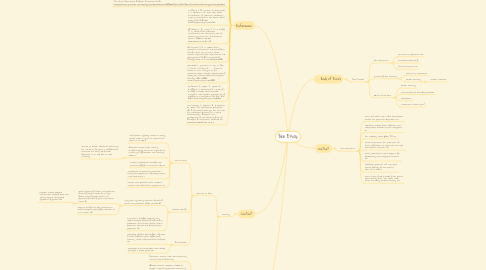
1. References
1.1. Iwasaki, J., Barratt, B., Lord, J., Mercer, A., & Dickinson, K. (2015). The new zealand experience of varroa invasion highlights research opportunities for australia. Ambio, 44(7), 694-704. doi:10.1007/s13280-015-0679-z
1.2. (2) Bees in protection plan. (2013, June 29). The Advocate, p.62. Retrieved from: https://search-proquest-com.ezproxy.ecu.edu.au/docview/1372091091?OpenUrlRefId=info:xri/sid:wcdiscovery&accountid=10675
1.3. (3) Vanbergen, A. J. (2013). Threats to an ecosystem service: pressures on pollinators. Frontiers in Ecology and the Environment, 11(5), 251-259. doi10.1890/120126
1.4. (4) King, P., & Robinson, S. (Directors). (2015). What's killing our bees? [Motion picture on Online video]. BBC Worldwide.
1.5. (5) Dr. Perrone, S., & Malfroy, S. (2014). BeeForce australia part i. Bee World, 91(2), 36-37. doi:10.1080/0005772X.2014.11417591
1.6. (6) Hannan, P. (2016). Varroa mite: Are we ready? The North Queensland Register. Retrieved from: https://search-proquest-com.ezproxy.ecu.edu.au/docview/1813951611?OpenUrlRefId=info:xri/sid:wcdiscovery&accountid=10675
1.7. (7) Eilers, J. E., Kremen, C., Greenleaf, S. S., Garber, K. A., Klein, AM. (2011). Contribution of pollinator-mediated crops to nutrients in the human food supply. PLOS ONE (6)6. doi:10.1371/journal.pone.0021363
1.8. (8) Burkle, L. A., Marlin, J. C., & Knight T, M. (2013). Plant–pollinator interactions over 120 years: loss of species, co-occurrence, and function. Science 339(6127), 1611–1615. Doi10.1126/science.1232728
1.9. (9) Forrest, J. R. K. (2014). Plant- pollinator interactions and phenological change: what can we learn about climate impacts from experiments and observations? OKIOS Synthesising Ecology, 124(1), 4-13. doi: 10.1111/oik.01386
1.10. (10) Wolf, S., McMahon, D., Lim, K., Pull, C., Clark, S., Paxton, R., . . . Raine, N. (2014). So near and yet so far: Harmonic radar reveals reduced homing ability of nosema infected honeybees. Plos One, 9(8), 103989. doi:10.1371/journal.pone.0103989
1.11. (11) Fischer, J., Müller, T., Spatz, A., Greggers, U., Grünewald, B., Menzel, R., & Naug, D. (2014). Neonicotinoids interfere with specific components of navigation in honeybees. Plos One, 9(3), 91364. doi:10.1371/journal.pone.0091364
1.12. (12) Joachim, C., Vosteen, I., & Weisser, W. (2015). The aphid alarm pheromone (E)-β-farnesene does not act as a cue for predators searching on a plant. Chemoecology : Evolution and Mechanisms of the Chemical Base of Ecological Interactions, 25(3), 105-113. doi:10.1007/s00049-014-0176-z
2. Content
2.1. security
2.1.1. threats to bees
2.1.1.1. Varroa mite
2.1.1.1.1. infestation typically results in colony death within 4 years (1) (cited from klein et al. 2007)
2.1.1.1.2. Australia remains last country unaffected by Varroa (1) (cited from Ministry of Agriculture and Forestry, 2002a)
2.1.1.1.3. invasion possibilities through post, personal luggage or container ship (1)
2.1.1.1.4. capabilities to decimate australian honey bee population, negatively impact crops severely (2)
2.1.1.1.5. carries viral diseases that weakens colonies and reduces bee populations (5)
2.1.1.2. climate change
2.1.1.2.1. May alter synchrony between flowering plants and pollinator flight periods (8)
2.1.1.2.2. increases in drought severity may reduce survival, flowering and nectar production for certain plants. lowers pollination success and declines plant population (9)
2.1.1.3. Incesticides
2.1.1.3.1. pesticides affect bee's higher cognitive process. Affects their flight path memory. Leave infected bees confused (11)
2.1.1.3.2. pesticides (neonecotinoids) cause deadly paralysis in small pests (10)
2.1.2. threats to crops
2.1.2.1. Pollination reliant crops threatened by Varroa infecting bees (6)
2.1.2.2. 480,000 colonies would be needed to provide necessary pollination services if wild honeybee population services were eliminated by varroa (6)
2.1.2.3. pollinators play crucial role in farming, yielding larger crops with higher nutrients (7)
2.1.2.4. more then 65% of crops in Australia depend on pollination (13)
3. content
3.1. protecting the future of Australian biosecurity
3.1.1. E- b farnesene. Can be a way to be less dependent on pesticides. Alternative, affective in deterring aphids from crops and poses no risk to bees. (12)
3.1.2. $587,000 for national bee pest surveillance program. Includes virus diagnostics, deploying catch boxes, bee virus surveillance, early warning systems for new threats before they establish (13)
4. Body of Essay
4.1. Topic Focuses
4.1.1. bee importance
4.1.1.1. threats to pollinators link
4.1.1.2. horticulture/farming
4.1.1.3. financial importance
4.1.2. protecting bee security
4.1.2.1. threats to pollinators
4.1.2.2. border security
4.1.2.2.1. invasion threats
4.1.3. What can be done
4.1.3.1. border security
4.1.3.2. alternatives to harmful pesticides
4.1.3.3. surveillance
4.1.3.4. eradication back up plan?
5. content
5.1. bee importance
5.1.1. more then 65% crops in Aus horticulture sector are pollination dependant (1)
5.1.2. wild bees provide free, efficient and independent services to the ecosystem (1)
5.1.3. bee industry worth $90M P/Y (2)
5.1.4. crucial importance for pollination of fruit, vegetable, oil, seed and nut crops- vital human nutrition (3)
5.1.5. insect pollination critical support for biodiversity and ecosystem services (3)
5.1.6. stabilises yields of 75% crop plant species globally (3) (as cited in Klein et al. 2007)
5.1.7. most animal feed is made from plants pollinated by bees- bee losses risks meat and dairy product security (4)
